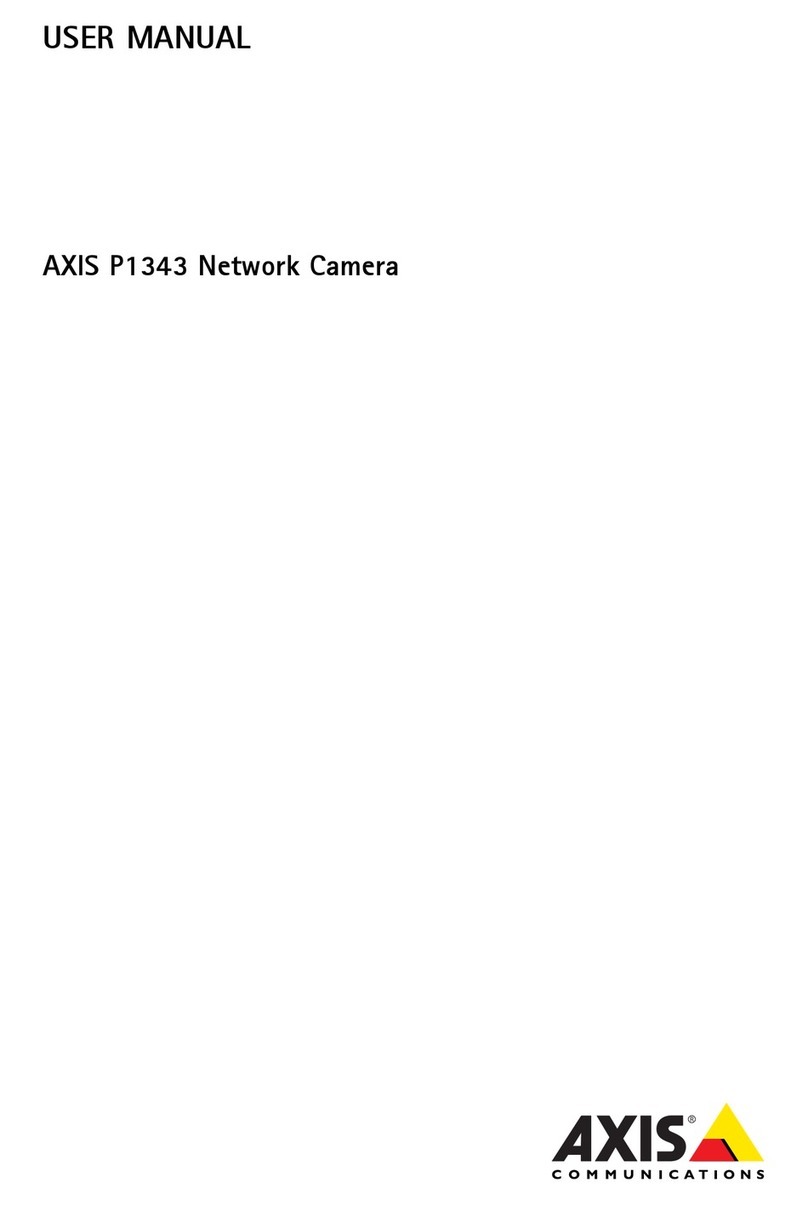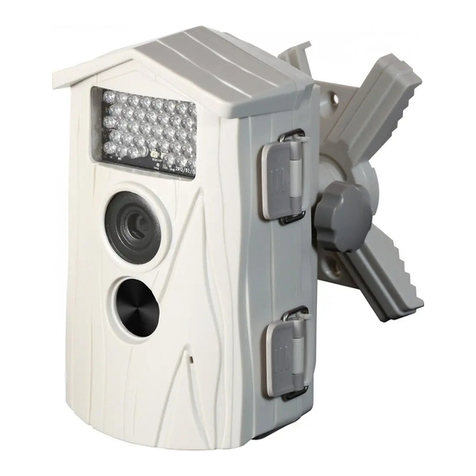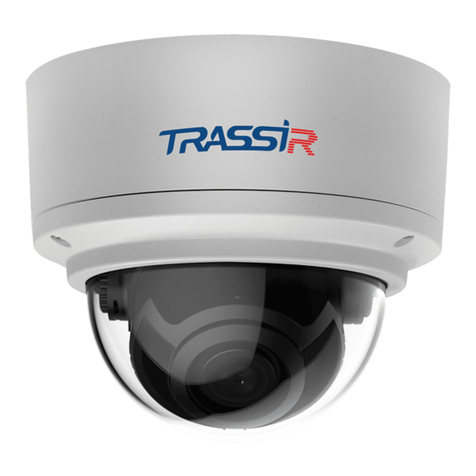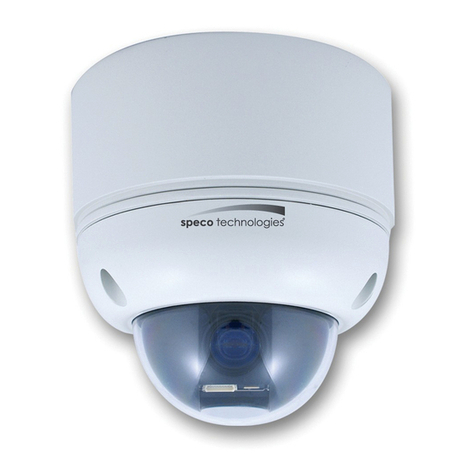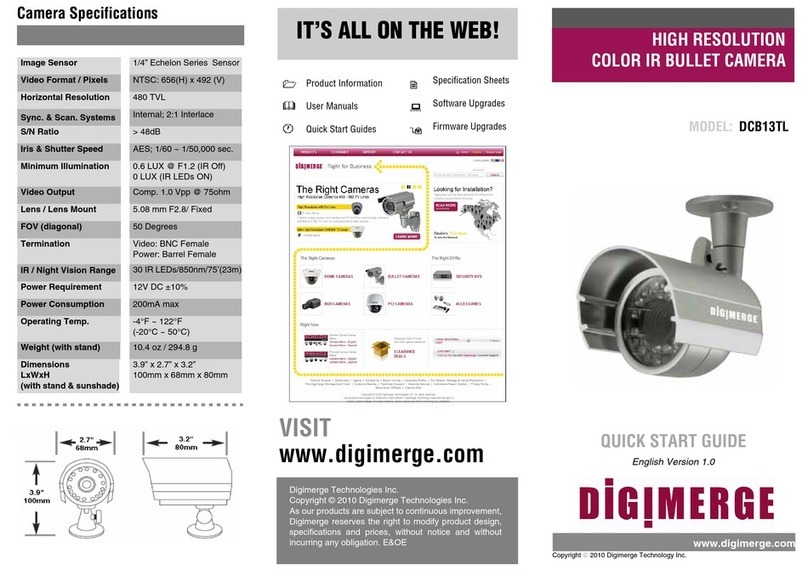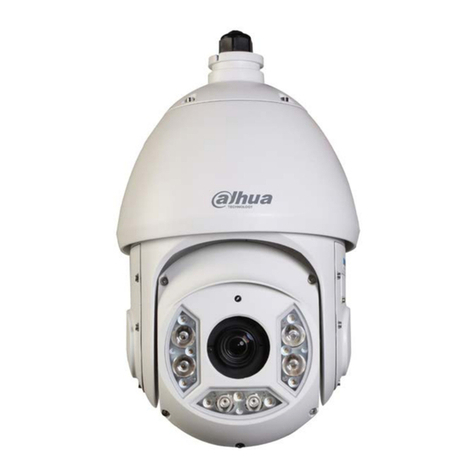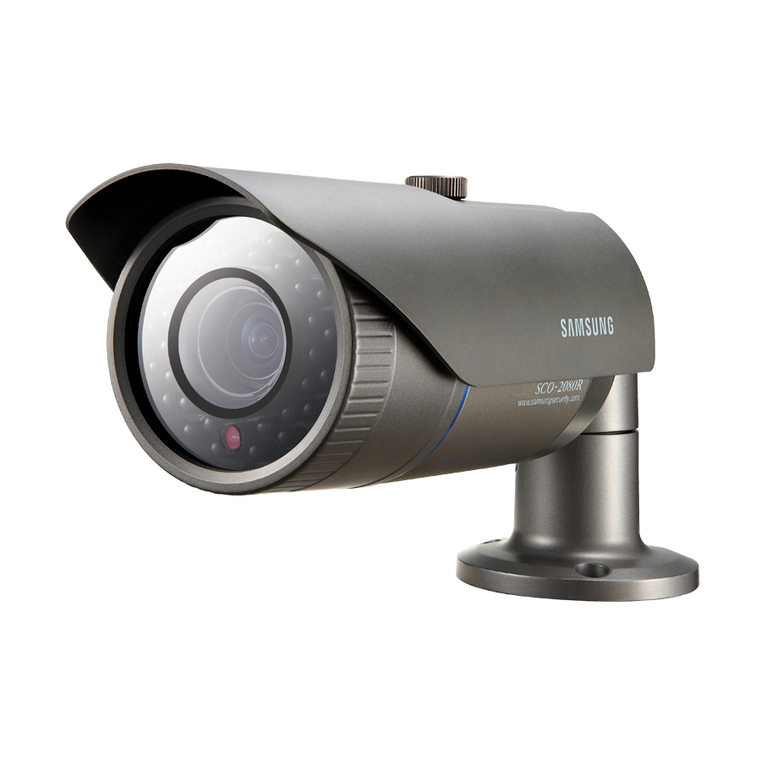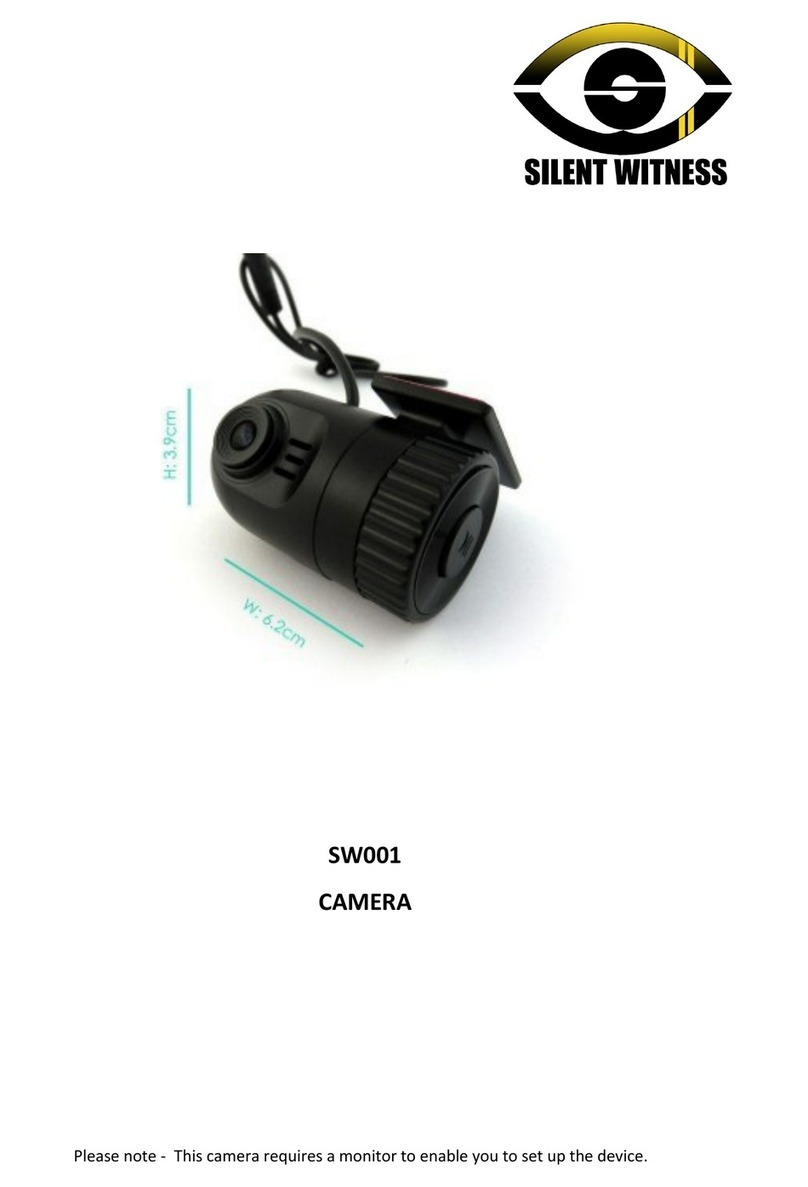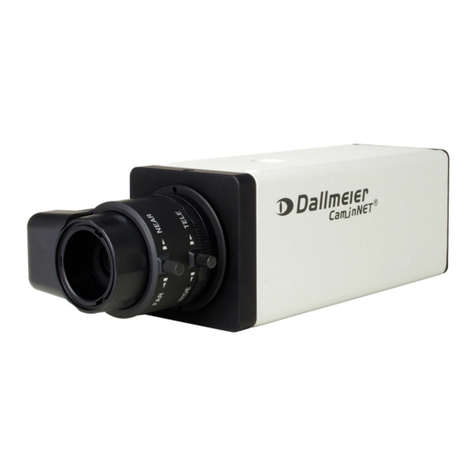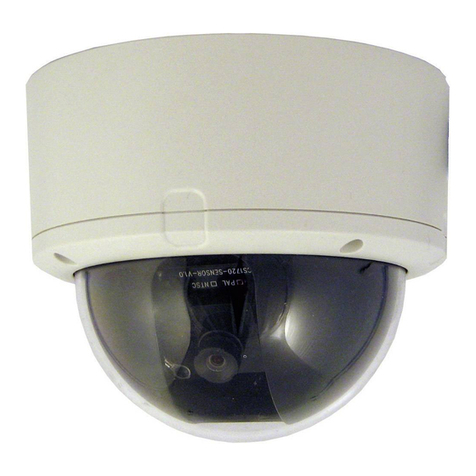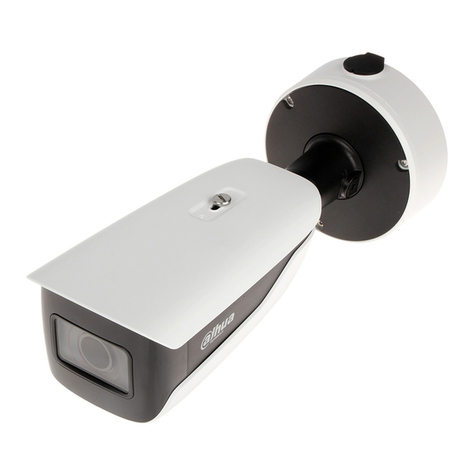Tokyo Electronic CS8320B User manual

CCD Monochrome
Video Camera
CS8320B (E IA)
CS8320BC (CCIR)
Operation Manual
TOKYO ELECTRONIC INDUSTRY CO.,LTD:
For customer Use
Enter below the Serial No. which is located on the bottom
chassis of the camera.
Retain this information for future reference,
Model No. CS
Serial No.
CAUTION
To prevent electric shock, do not use the polarized plug of the
AC Power adapter with an extension cord, receptacle or other
outlet unless the blades can be fully inserted to prevent blade
exposure.
When the camera is used within an electromagnetic field, beat
interference (vertical, horizontal or diagonal stripes) may be
created in the video output. If this occurs, take measures on the
source of the electromagnetic waves to prevent the emissions
from affecting the video output.
Such measures are particularly necessary on systems with
servo motors, inverters and other equipment that tends to
generate electromagnetic waves.
Do not subject the camera to strong shocks, as this may result
in failure or breakage.
When the camera is used on systems which subject the camera
connector to strong shocks, the camera connector may suffer
damage. If the camera is used on such systems, the connector
plug should be fastened to the camera with the optional camera
connector bracket.

WARNING
TO PREVENT FIRE OR SHOCK HAZARD, DO NOT
EXPOSE THIS APPLIANCE TO RAIN OR MOISTURE.
This equipment should be used with DC12V only. Do not
use any other power source.
INFORMATION
This equipment generates and uses radio frequency energy and if not
installed and used properly, that is, in strict accordance with the
manufacturer's instructions, may cause interference to radio and
television reception. If does so, which can be determined by turning
the equipment off and on, the user is encouraged to try to correct the
interference by one or more of the following
measures:
the receiving antenna ;
Relocate this equipment with respect to the receiver ;
Move this equipment away from the receiver ;
Plug this equipment into a different outlet so that this equipment
and receiver are on different branch circuits.
If necessary, the user should consult the dealer or an experienced
radio/television technician for additional suggestions.
CONTENTS
1. FEATURES ....................................................................................... 1
2. PRECAUTION ................................................................................ 1
3. CONTROLS AND ADJUSTMENT ........................................... 3
4. CONNECTIONS ............................................................................ 10
5. OPERATION ................................................................................... 14
6. SUPPLEMENTAL INFORMATION ........................................ 14
7. TROUBLE-SHOOTING GUIDE .............................................. 16
8. SPECIFICATIONS ......................................................................... 17
9. CONSTITUTION ........................................................................... 23
10. HOW TO FIX CAMERA ............................................................... 24
11. APPEARANCES .............................................................................. 25
12. MAINTENANCE ............................................ ................................ 26

Thank you for purchasing the TELI CS8330B/CS8330BCCS8311BC TV B/W
camera featuring compact and light weight.
To take best advantage and gain the most service from your camera,
read this operation manual carefully and thoroughly.
1. FEATURES
* Compact and light weight.
* Available External sync-operation.
* One piece configuration.
* Equipped with AGC (Automatic Gain Control) which allows wide
dynamic range from bright to dark subjects.
* Equipped with an electronic shutter for fast moving subjects for
better definition picture.
* Using the Restart-Reset function, it is possible to acquire the image
at any timing according to the R.R pulse input (VD input). (This
function can be turned ON/OFF by an internal switch.)
* Using the special shutter function, it is possible to acquire the image
at any shutter timing or shutter speed according to the shutter trigger
and R.R pulse inputs. (This function can be turned ON/OFF by an
internal switch.)
2. PRECAUTION
(1) This equipment should be used with DC12V only.
To prevent electric shocks and fire hazards, do not use any other
power source.
(2) The CS8330B/CS8330BC is designed to be used with EIA/CCIR
monochrome television signals. It cannot be used for playback
with a television of a different standard.
(3) Please handle the equipments carefully.
- 1 -
(4) Do not point your camera lens directly into sunlight or strong
artificial light. This might cause irreparable damage to the image
sensor.
Also, be sure to use the lens cap when the camera is not in use.
(5) Do not expose the camera unit to high temperatures. For example,
do not place it near a stove for long periods, or in direct sunshine
or in a car in hot weather. Heat may cause some malfunction.
(6) Keep the camera clean. Dust can damage the camera and cause
trouble in moving parts.
Take particular care to avoid the entry of sand or grit when
changing the camera lens.
(7) Avoid jolting the equipments or exposing it to vibration.
(8) Never attempt to dismantle the equipments.
(9) Avoid folding or stretching the camera cable or other connection
cable between equipments.
(10) When the cabinet is dusty, clean by gently wiping with a soft
cloth. And avoid the use of strong cleaning agents such as
benzine or alcohol as they may damage the cabinet.
IMPORTANT
The camera provides four screw holes at the bottom chassis
which are used to mount the attachment plate for tripod and so
on.
Do not use longer screws over 4mm. Because there is a
printed circuit board closed to the bottom chassis, and the PC
board may cause damage it.
- 2 -

3. CONTROLS AND ADJUSTMENTS
Get to know the name and function of every part of your camera.
That way, you can take advantage of every applications to take
beautiful pictures.
The body and accessories shown below.
3-1. Lens
(1) Iris ring
(Aperture ring) for use at manual operation. To reduce aperture,
rotate the iris ring toward CLOSE (clockwise). To increase
aperture, rotate the iris ring toward OPEN (counter clockwise).
Adjust the lens aperture according to the amount of light entering
the lens so that correct exposure is obtained.
(2) Focus ring
Take the focus with the ring to focus for the sharpest picture.
* CS8330B/CS8330BC camera is equipped with "C" mount lens, and
you can use any C-mount lenses according to your applications.
* No lens is included in the provided accessories, make choice of the
most appropriate lens as necessary.
3-2. Camera Rear Panel
①GAIN adjustment pot.
Turn it clockwise to increase video gain.
②GAIN selection switch
When the gain selection switch of this camera is set to the right
position (AGC), the AGC function becomes effective. The gain
becomes fixed when this switch is at the middle position (FIX).
When this switch is set to the left position (MG ; Manual Gain),
the gain can be adjusted manually by rotating the gain adjustment
knob ①
(The switch is set to the FIX position when shipped from the
factory.)
③SHUTTER (Electronic Shutter)
The camera incorporates an electronic shutter with a variable
speed function ranging from 1/50 to 1/10,000th seconds, allowing
for better definition of a subject moving at a high speed. Normally,
put it "OFF" position at the left side, which is set a shutter speed of
1/60 (EIA) or 1/50 (CCIR) seconds. When required electronic
shutter, put it "ON" position and select any speed required the
system by the switch on PC board in the camera.
④VIDEO OUT connector
The composite video signal is come out from this connector
which is employed with BNC type.
⑤DC IN/SYNC connector
This connector is composed of 12 pins, and DC12V, HD, VD-
inputs, Clock pulse, Video output and so on, their assignment are
as the table in page 12 for more detail.
- 4 -
- 3 -

- 5 -
QTop view after opening the camera cover
3-3. Explanation of internal selection switches
The internal structure of this camera is as shown in the figure
below.
QSide view after opening the camera cover
(1) Method of setting the different modes
The different modes can be set using the switch S4 in the
CONTROL board. The mode can be selected by moving the DIP
switches 1 to 6 to the left or the right position.
Each switch becomes OFF in the left position and ON in the right
position. At the time of shipment from the factory, all the
switches will have been set to the left position.
(2) "GAMMA" (Gamma correction)
Generally, TV camera provides gamma correction in the video-
process amplifiers which make up opposite side for non-linear
characteristics based on CRT's electron gun in TV receiver, and the
total performances of the video system have linear (gamma ; 1.0).
Usually, use the gamma correction "ON" position which set the
standard camera gamma-value of 0.45. And if required gamma
"OFF" (gamma value ; 1.0) with the system, turn it to "OFF"
position.
- 6 -
Switch setting position
No. Function name OFF ON
1 gamma correction 1.0 0.45
2 CCD operation mode Frame store Field store
3 Restart-Reset OFF ON
4 Special shutter OFF ON
5 Not used ---------- ----------
6 VD/FLD output VD output FLD output

No. Shutter speed (sec.)
0 Normal mode
1 1/125
2 1/250
3 1/500
4 1/1000
5 1/2000
6 1/4000
7 1/10000
8 Flicker-less
9 Flicker-less
(3) Shutter speed
When required electronic shutter, put SHUTTER switch on the
rear panel to "ON" position and select any speed.
(4) "F.L" (Flicker-Less)
Where the illumination of fluorescent lamps are used in the power
frequency area of 50Hz (EIA) or 60Hz (CCIR), a flicker may
appear on the picture. And if set S1 to "F.L" position according
to the table, it will be set the shutter speed 1/100 seconds or 1/120
seconds, resulting in decrease the flicker on the picture.
(5) Method of setting the electronic shutter speed
The shutter speed can be set using the switch S1 in the CONTROL
board.
The relationship between the switch position and the shutter speed is
as follows.
(6) HD-VD output
HD and VD pulses are come out from pin 6-5 (GND) for HD,
and pin 7-12 (GND) for VD of DC IN/SYNC connector on the
rear panel by the following measures when the system is required.
(7) HD-VD IN/OUT selection method
The HD-VD IN/OUT selection can be made using the switch S2
in the CONTROL board.
This switch will have been set to the HD-VD IN position at the
time of shipment from the factory. To change this setting to
HD-VD OUT, set S2 as shown in the figure below.
(8) Clock pulse
The clock pulse is come out from pin 9-8 (GND) of DC IN/SYNC
connector on the rear panel by the following measures, as necessary.
(9) TRG IN/CLK OUT selection method
The TRG IN/CLK OUT selection can be made using the switch
S1 in the SYNC board.
This switch will have been set to the TRG IN position at the time
of shipment from the factory. To change this setting to
CLK OUT, set S1 as shown in the figure below.
-
8
-
- 7 -

(10) External SYNC signal input impedance selection method
The external SYNC signal input impedance can be selected using
the switch S3 in the CONTROL board.
At the time of shipment from the factory, this switch will have
been set to the High Impedance position. To change this setting
to 75 Ω, set the switch S3 as shown in the figure below.
(11) Video output AC coupling/DC coupling selection method
The AC coupling/DC coupling selection can be made using the
switch S1 in the PROCESS board.
This switch will have been set to the AC coupling position at the
time of shipment from the factory. To change this setting to DC
coupling, set S1 as shown in the figure below.
- 9 -
4. CONNECTION
When installing the CS8330B/CS8330BC camera to your system,
you have to connect between equipments.
4-1. Typical connection.
* AC adapter CA130B/140B is an optional accessory, make choice of
the most appropriate power supply system, depending on the
application.
* Typical connection of CS8330B/CS8330BC. There are two
connectors of "VIDEO OUT", and "DC-IN/SYNC" at the rear panel
on the camera.
- 10 -

4-2. Connection Between Other Equipments Excluding
CA130B/CA140B
4-3. DC IN/SYNC connector pin assignment
The connector is combined with DC12V input, and some other, and
recommended to use the system including an image processor.
They are composed of 12pins, and the pin assignment is as
followings.
QCamera connector ; HR10A-10P-12P (Maker ; Hirose denki)
* HD,VD output is available for internal switch selection.
* Clock output is available for internal switch selection.
The clock output cannot be made when the shutter trigger is being
input (when the special shutter function is being used).
- 12 -
-
11
-
CAUTION
When using the camera on systems that accept EC (EMC)
instructions, be sure to use the optional shielded camera cable
(CPSC3000 or equivalent).
CAUTION
When using the camera on systems that accept EC (EMC)
instructions, be sure to attach the ferrite core (included as an
accessory) to the camera end of the camera cable.
External synchronizationPin
No. HD and VD VS/SYNC Restart-Reset
Internal
Svnchronization
1 GND GND GND GND
2 +12V +12V +12V +12V
3 Video output
(GND)
Video output
(GND)
Video output
(GND)
Video output
(GND)
4 Video output
(signal)
Video output
(signal)
Video output
(signal)
Video output
(signal)
5 HD input
(GND)
------------------------------
-
HD input
(GND)
HD output
(GND)
6 HD input
(signal)
------------------------------
-
HD input
(signal)
HD output
(signal)
7 VD input
(signal)
VS/SYNC input
(signal)
R.R input
(signal)
VD output
(signal)
8
Shutter trigger input/
Clock output
(GND)
Shutter trigger input/
Clock output
(GND)
Shutter trigger input/
Clock output
(GND)
Shutter trigger input/
Clock output
(GND)
9
Shutter trigger input/
Clock output
(signal)
Shutter trigger input/
Clock output
(signal)
Shutter trigger input/
Clock output
(signal)
Shutter trigger input/
Clock output
(signal)
10 GND GND GND GND
11 +12V +12V +12V +12V
l2 VD input
(GND)
VS/SYNC input
(GND)
R.R input
(GND)
VD output
(GND)

(1) DC12V input
Connect pin number 2 and/or 11 for DC12V (HOT) and Pin
1 and/or 10 for GND.
(2) Video output
Composite EIA or CCIR video output (VS) is output from 4
(HOT) and 3 (GND).
CAUTION
There are two video output which are from VIDEO OUT
(BNC) and DC IN/SYNC pin 4-3 (GND).
Do not use both of them at the same time, because it may
occur double termination with the video output, and the
video output will be half.
(3) Input pulses for external sync
When required external sync-operation between other
equipments, use either one of pulses for HD/VD, VS or SYNC.
And input HD pulse from pin number 6-5 (GND) and VD from
pin 7-12 (GND) for HD/VD external sync operation. And input
VS or SYNC from pin 7 and 12 (GND) for external sync
operation by VS or SYNC.
(4) Clock pulse
Clock Pulse is come out from pin 9-8(GND) when the system
required it, refer to page 8.
- 13 -
5. OPERATION
(1) After the connection between equipments, turn the power
switches for the video monitor on at the first.
(2) Turn the power switch for the camera to ON, and make sure the
image appears on the monitor screen.
(3) Adjust the lens aperture for the proper image brightness.
(4) Adjust the focus ring on the lens for the sharpest picture looking
at the monitor.
6. SUPPLEMENTAL INFORMATIONS
(1) Illuminance for better picture
"illuminance" (also called "luminance") is intensity or brightness
of light, expressed in lux.
The CS8330B/CS8330BC is designed to provide best pictures
under the conditions of a 1500 lux illuminance, although shooting
is possible all the way down to 2 lux with the GAIN switch while
AGC position.
To obtain good pictures under very bright object, the use of an
ND (neutral density) filter is recommended.
(2) Smear
When the strong light hits the CCD image sensor, the image of
bands in vertical direction may appear above and under the spot.
This is called smear. Especially if the camera shoots under the
noon sun or its reflections, a candlelight in the dark, or headlights
of cars, this smears may stand out in the picture.
The CCD used with the CS8330B/CS8330BC is designed against
the smear. However, watch out for smear when shooting involves
a strong light sources.
- 14 -

(3) Lenses
Generally, there are many kind of C-mount lenses for the video
camera on the market, for example, different aperture (iris),
different focal distance, zoom lenses and so on. Those having a
shorter focal distance are called "wide-angle" lenses, and those
having a longer focal distance are called "telephoto". Lenses of
different focal distances have special characteristics and you can
take advantage of these in shooting. When the camera is fit with
a zoom lens, it is extremely easy to vary the focal distance.
Anyhow, make choice of the most appropriate lens for your
application or system.
IMPORTANT
To ensure maximum performance, be sure to keep the inside
of lens and inner part of camera module free from dust or
fingerprint.
CAUTION
If the lens (C-mount) size exceeds 100mm in diameter, 170mm
in length and 1Kg in weight, both the camera and lens should be
secured.
Because the camera housing-strength is not enough to support
such a weight or stress, may cause damage it.
- 15 -
7. TROUBLE-SHOOTING GUIDE
What may initially appear to be trouble is not always a real problem.
Make sure first according to the following table before requesting
service.
-
16
-
Symptoms Check points
* Is the power supply unit correctly connected ?
* Is the POWER switch of the connected AC
Power
No power
is supplied adapter set to ON ?
No picture * Lens cap on.
* Is it extremely dark on subjects ?
* Improper connection or setting.
* Other system equipments work properly.
* Connection cables between equipments are
properly.
* Camera setting (switches and others) are right
position.
Focus or picture * Dirt on camera lens.
not sharp * Lens improperly focused.
* Is proper lens installed or set ?
Picture not * Exposure of camera lens to extremely bright,
satisfactory does ND filter need
* Inadequate lighting (dark).

(1) TV system
CS8320B Based on RS-170 standard
CS8320BC
Based on CCIR standard
(2) Imagesensor Interline CCD
Active pixel
CS8320B 768 (H) X 494 (V)
CS8320BC 752 (H) X 582 (V)
Chip size
CS8320B 8.4 µ m x9.8 µm
CS8320BC 8.6 µ m x8.3 µm
Active image area 6.4 mm (H) x4.8 mm (V)
(equivalent to 1/2" normal
optical image size respectively.)
(3) Number of scanning lines
CS8320B 525 lines
CS8320BC
625 lines
(4) Scanning system
2 : 1 interlace
(5) Sync. system Internal/External
(automatic change over)
(6) Scanning frequencies
Horizontal drive (H)
CS8320BB15.734 kHz
CS8320BC 15.625 kHz
Vertical drive (V)
CS8320B 59.94 Hz
CS8320BC
50 Hz
(7) Aspect ratio 4 : 3
(8) Sensitivity
Standard 100 lx at F4, 3200 K
GAIN; FIX, Gamma = 1.0
Minimum 0.5 lx at F1.4
Gain max., Gamma = 0.45
(9) Video output
VS (Video + SYNC)
1.0 Vp-p/75 Ω
(10) Resolution
Horizontal direction
CS8320B 570 TVlines
CS8320BC 560 TVlines
Vertical direction
CS8320B 485 TVlines
CS8320BC
575 TV lines
(11) S/N (luminance) 56 dB(p-p)/rms or more
(GAIN; FIX Gamma = 1.0 )
(12) Input signal
External sync pulses
HD, VD, R.R and SYNC 4.0 ± 2.0 V(p-p)
VS 1.0 V(p-p) (SYNC 0.3 Vp-p)
Input impedance 75 Ω/ HIGH selection can be
made using the internal switch.
(Factory setting ; HIGH)
Pulse polarity Negative polarity
Pulse width
HD 6.4 X 3 µs
VD 150 to 800 µs
- 17 - - 18 -
8. SPECIFICATIONS

Frequency
Horizontal (fH)
CS8320B15.734 kHz ± 2 %
CS8320BC15.625 kHz ± 2 %
Vertical (fV)
CS8320B2fH/525
CS8320BC 2fH/625
Number of scanning lines
CS8320B525 lines
CS8320BC625 lines
Phase between HD/VD The phase relation between HD
and VD should be as shown
below.
t1=0±5µs t2=1/fH/2±5µs
(13) Output signal
Clock pulse The clock pulse is available, if
necessary.
Pulse level 2.5 Vp-p/high impedance
Frequency
CS8320B14.318181 MHz ± 100 ppm
CS8320BC14.1875 MHz ± 100 ppm
HD/VD pulses
Pulse level 4.5 Vp-p/high impedance
Interlace 2 : 1
Polarity Negative
Pulse width
HD
CS8320B6.36 ± 0.1µs
CS8320BC6.41 ± 0.1µs
VD
CS8320B572 ± 1µs
CS8320BC480 ± 1µs
Frequency
Horizontal (fH)
CS8320B15.73426 kHz ± 2 Hz
CS8320BC15.625 kHz ± 2 Hz
Vertical (fV)
CS8320B2fH/525
CS8320BC
2fH/625
(14) Sensitivity setting The following modes can be set
using the panel selection switch.
(Factory setting ; FIX)
FIX (FIX Gain); Standard
sensitivity setting.
AGC (Automatic Gain Control)
MGC (Manual Gain Control)
(15) AGC
Operating range Stabilized by AGC within 2 dB
for ± 6dB of the output signal
variation.
(16) MGC
Sensitivity can be set manually.
(17) Gamma correction 0.45/1.0 selectable
- 20 -
- 19 -
1st FIELD for EIA 2nd FIELD for EIA
2nd FIELD for CCIR 1st FIE
L
D for CCIR
VD
or
R. R
HD

(18) White clip Clip level should be set for 1.0V
at factory, excluding SYNC tip.
(19) Electronic shutter ON/OFF selectable
Shutter speed 1/125, 1/250, 1/500, 1/1000,
1/2000, 1/4000, 1/10000 sec. and
flicker-less (1/100 or 1/120)
(20) Special shutter Any shutter timing and shutter
speed can be set according to the
shutter trigger and R.R pulse
inputs.
This function can be turned
ON/OFF by an internal switch.
(Factory setting ; OFF)
(21) CCD operation mode Field or frame store mode can
Be selected as necessary.
(initially preset frame mode in
factory)
(22) Restart Provides ON/OFF switch inside
of the camera.
(23) Spectral response Refer below.
(24) Power source DC12V ± 10 %
(within 10mVp-p ripple)
(25) Power consumption approx. 230 mA
(26) Ambient condition
Temperature 0 °C to +40 °C
Humidity
less than 90 %
(27) Lens mount
C-mount
(28) Dimensions
44 (W) X 29 (H) X 78 (D) mm
(refer to pages 25)
(29) Weight
approx. 120 g
* Design and specifications are subject to change without notice.
- 22 -
- 21 -

9. CONSTITUTION
(1) Camera module (without lens) 1 pc.
(2) Provided accessories
Operation manual 1 pc.
Ferrite core 1 pc.
(3) Optional Accessories
Purchase the following optional accessories depending on your
system as necessary.
•Cable for AC power adapter CPC3440-03 (3m)
CPC3440-05 (5m)
CPC3440-10 (10m)
•BNC video cable
* Make choice of the most appropriate cables, according to your
system or application.
- 23 -
10. HOW TO FIX CAMER
A
(1) Use tripod
If you use tripod, use camera mounting kit (optional) and fix
camera.
(2) Use fixing holes on camera
If you use fixing holes on camera flange (2 holes), Please use
screw (M3). Please use screw length less then 4mm.
(3) Use fixing holes on the bottom of camera
If you use fixing holes on the bottom of camera, Please use screw
(M2).
Please use screw length less then 3mm.
* If you fix camera, we recommend to use both item (2) and (3).
- 24 -
•AC power adapter
CA130B AC 100V ± 10 %
CA140 AC 220V ± 10 %
DC12V, 0.9A
Dimensions
CA130B 92 (W) X 68 (H) X 120 (D) mm
CA140 125 (W) X 60 (H) X 130 (D) mm
Weight approx. 1 kg
CAUTION
If the screw is long, it touches with printed circuit board, and
it causes some trouble and accident.

11. APPEARANCES
- 25 -
12. MAINTENANCE
(1) Cleaning should be done only after the battery pack has been
removed or other power units have been disconnected.
(2) When the cabinet is dusty, clean by gently wiping with a soft
cloth. And avoid the use of strong cleaning agents such as
benzine or alcohol as they may damage the cabinet.
(3) If malfunctioning occurs, stop using equipment immediately and
consult TELI-service shop, the dealer purchased from or qualified
personnel.
(4) Upon completion of any service or repairs, request the service
technicians that only Factory Authorized Replacement Parts that
have the same characteristics as the original parts were used, and
that routine safety checks have been performed to determine that
the video product is in safe operating condition. Unauthorized
parts may result in fire, electrical shock, or other hazards.
(5) When you send the product to a service center, you must use the
original carton box and packing materials, then insert the original
carton box containing the unit into another carton, using more
packing materials.
(6) When requesting services, the following information is necessary.
* Your name, address and telephone number.
* Model number, serial number and date of purchase.
* Explain the damage, malfunction or other symptoms as precisely
as possible.
(7) The minimum availability period for repairs (parts necessary to
keep unit functioning) is 8 years after the end of producing the
model.
(8) If you have any question regarding after-sales service, etc., please
contact the nearest service center.
- 26 -
Specifications
Material
Lensmount : Galvanized dicust
Chassing, Rear panel : Aluminumed dicust
Cover : Aluminum steel plate
Color : Black
(
munse
l
l N1.5 leather satin
)
Other manuals for CS8320B
1
This manual suits for next models
1
Table of contents
Other Tokyo Electronic Security Camera manuals

Tokyo Electronic
Tokyo Electronic CS8550i-01 User manual

Tokyo Electronic
Tokyo Electronic CS8530-01 User manual

Tokyo Electronic
Tokyo Electronic CS3910H User manual
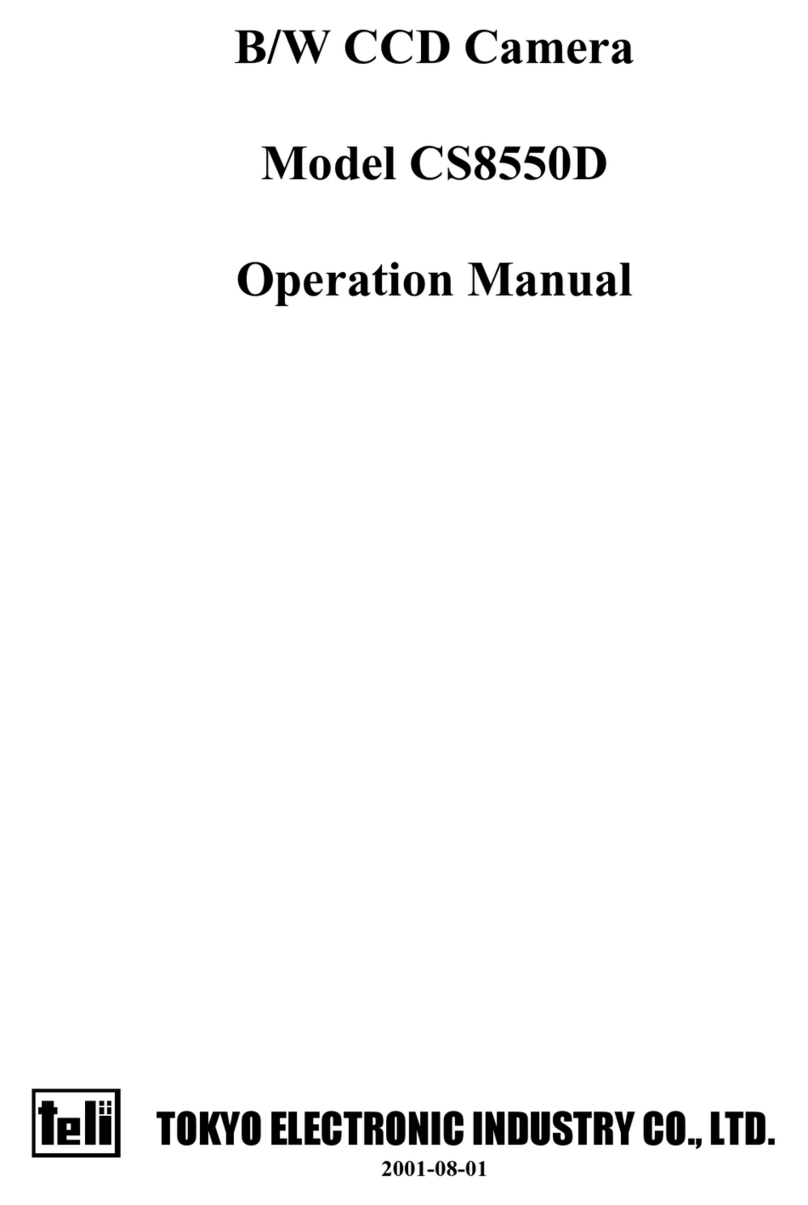
Tokyo Electronic
Tokyo Electronic CS8550D User manual
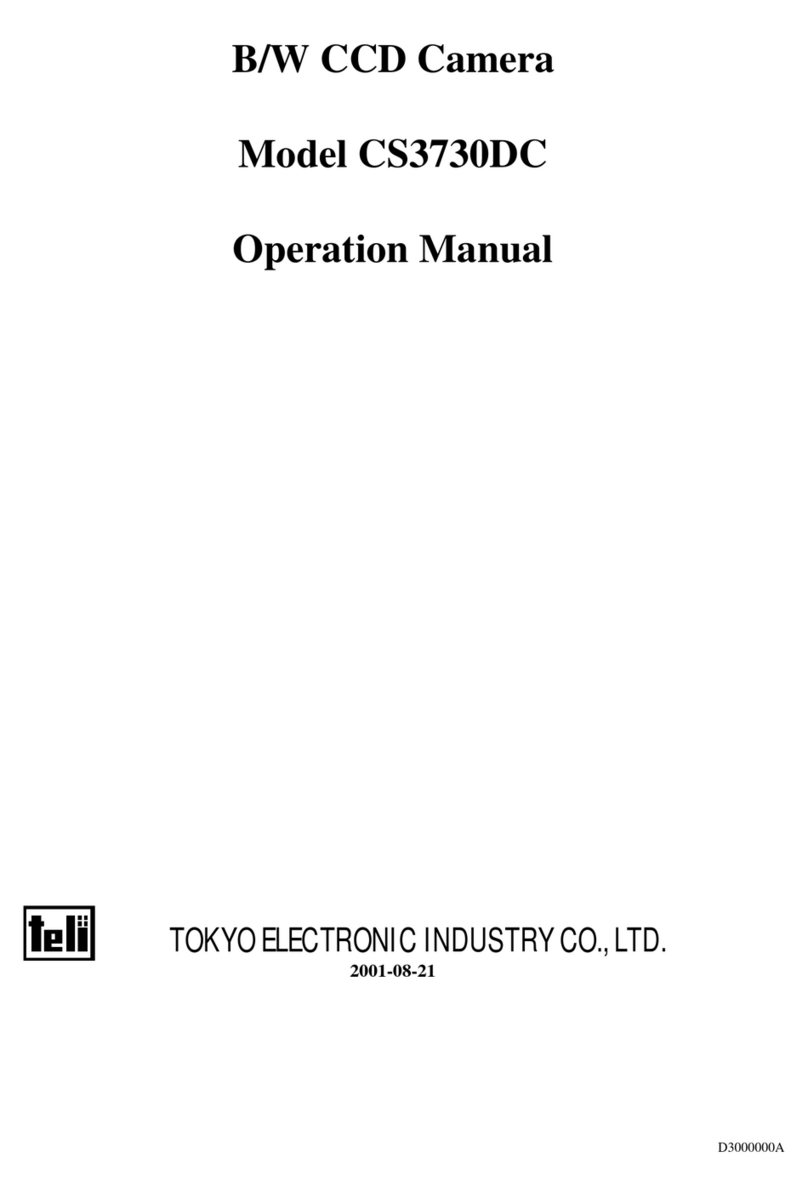
Tokyo Electronic
Tokyo Electronic CS3730DC User manual

Tokyo Electronic
Tokyo Electronic CS9200 User manual
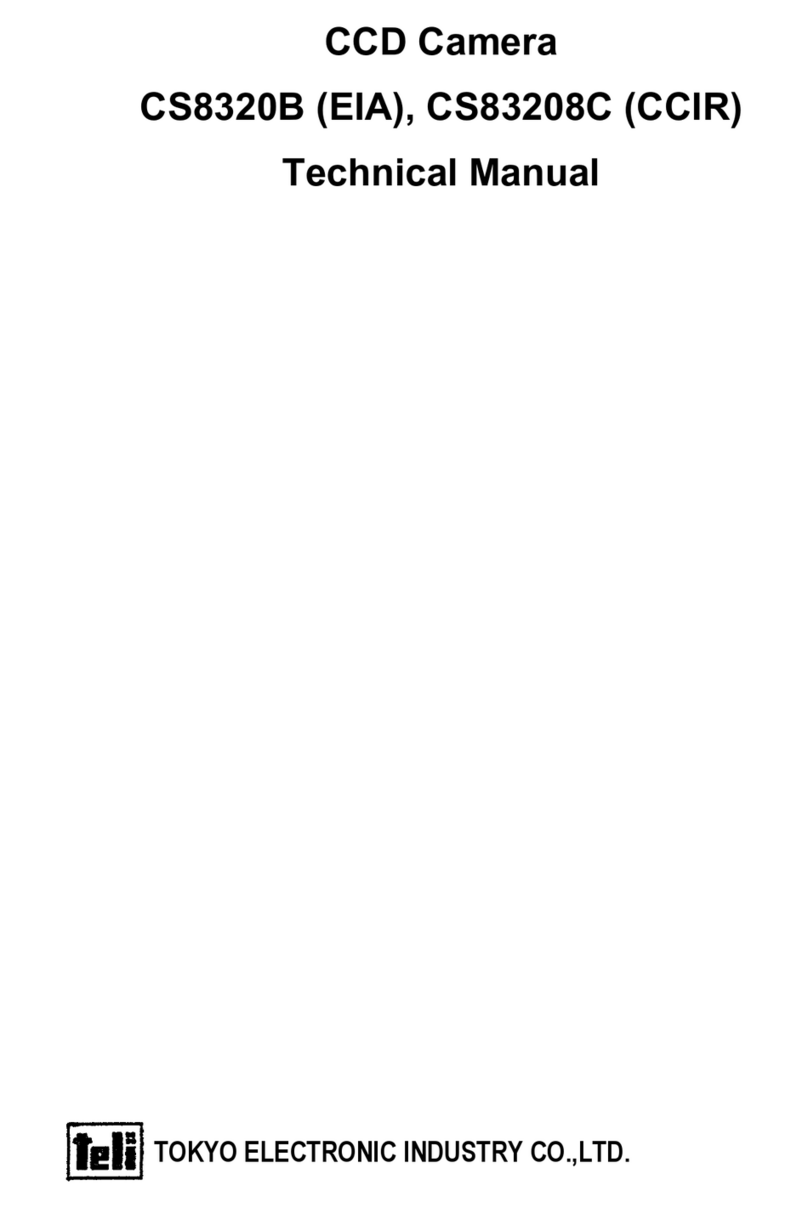
Tokyo Electronic
Tokyo Electronic CS8320B User manual
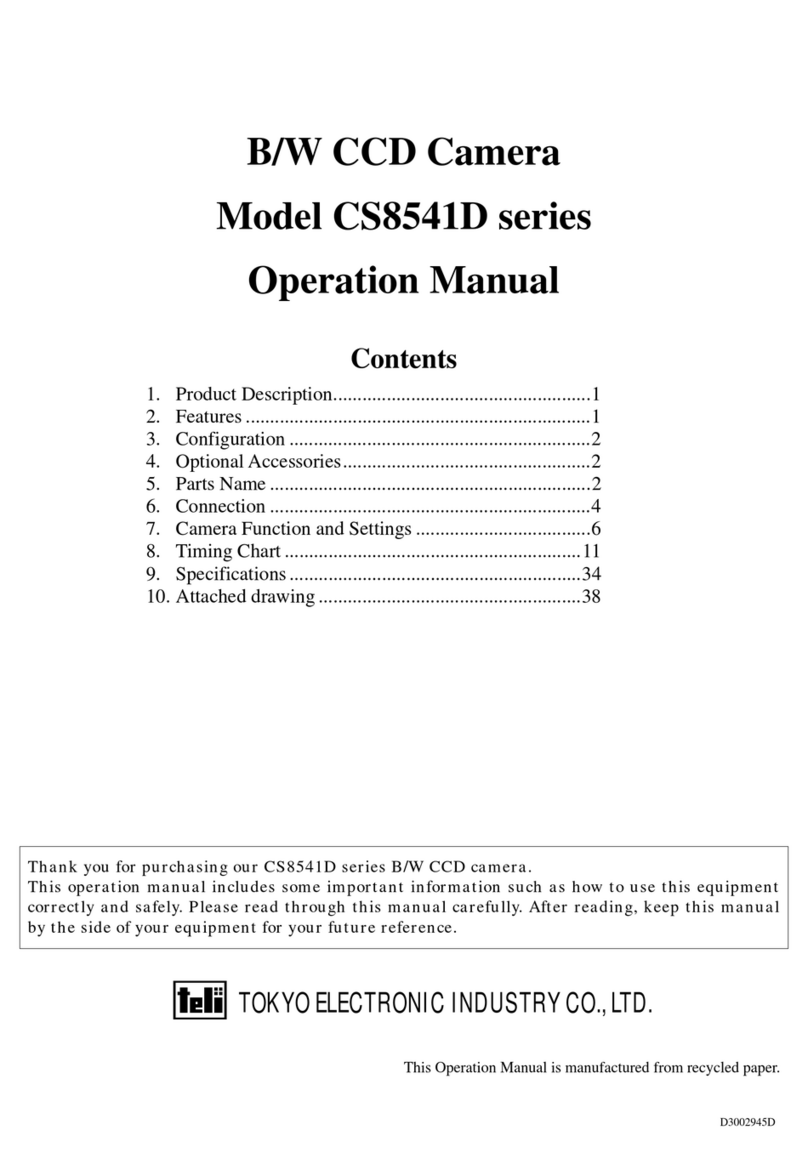
Tokyo Electronic
Tokyo Electronic CS8541D series User manual
